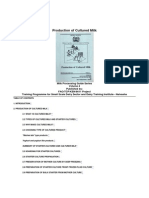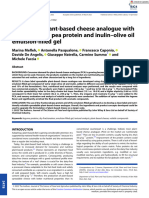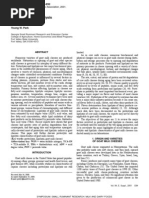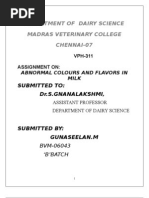Fermented Dairy Foods
Fermented Dairy Foods
Uploaded by
Tan NguyenCopyright:
Available Formats
Fermented Dairy Foods
Fermented Dairy Foods
Uploaded by
Tan NguyenCopyright
Available Formats
Share this document
Did you find this document useful?
Is this content inappropriate?
Copyright:
Available Formats
Fermented Dairy Foods
Fermented Dairy Foods
Uploaded by
Tan NguyenCopyright:
Available Formats
Fermented Dairy Foods
R. L. SELLARS
Chr. Hansen's Laboratory, Inc.
9015 West Maple Street
Milwaukee, Wl
INTRODUCTION of intestinal and other human and animal dis-
Fermented or cultured dairy foods offer orders of bacterial origin. Bailey and Shahani
exceptional nutritional and healthful attributes (57) reported that specific strains of Lacto-
to society. The dairy industry is fortunate to bacillus acidopbilus in vivo possess specific
have a naturally wholesome food, milk, which anticarcinogenic properties against Ehrlich
can be converted easily and relatively inexpen- ascite tumors in mice. This research suggests a
sively into products with superior nutritive possible similar response in man and animals
qualities. (57). Thus, fermented dairy foods contain and
Microorganisms of lactic acid starter cultures, exhibit nutritional and therapeutic benefits not
used for the conversion and preservation of clearly established with other foods.
milk by-products, are unique bioconvertors of Fermented dairy foods offer unique oppor-
energy. When they are used appropriately, these tunities and challenges to our industry and to
cultures elaborate specific metabolites during our society that are unavailable in many other
fermentation. These metabolites, in conjuction foods. The manufacturer/processor can benefit
with partial hydrolysis of milk constituents economically; the researcher/technologist has
(proteins, fat, and lactose), contribute to bet- several opportunities to develop new fermented
ter digestibility of the fermented food, and dairy food products; and, with bonafide market-
their nutritional and therapeutic qualities also ing/and sales promotion, the consumer will
are enhanced. recognize the importance of these foods for
Several lactic cultures synthesize certain B maintaining high nutrition and health at the
vitamins in fermented dairy foods (58, 70, 71). lowest cost per unit of protein energy available.
In contrast, directly acidified dairy foods do Many of our fermented dairy foods offer
not exhibit this enhancement. Also, lactic excellent opportunities for development as
cultures elaborate lactase and other enzymes ingredients or extenders in the preparation of
which, when in fermented foods containing other nutritious foods, either by adding nutritive
lactose, may contribute to the metabolism and value and by aiding in extension and preserva-
assimilation of lactose in lactose-intolerant tion of shelf life.
individuals.
In recent years, Shahani and Speck and their TRENDS
coworkers (70, 72, 74) showed that lactic
cultures, and especially certain species of lacto- Yogurt
bacilli, elaborate specific antimicrobial agents Yogurt is a perishable fermented dairy
which extend the shelf life of fermented dairy product which, unheated after fermentation,
foods by inhibiting a wide spectrum of food has a shelf life of up to 3 to 4 wk under refrig-
spoilage organisms. While current evidence does eration. Shelf life is dependent not only upon
not present proof, it strongly suggests that storage conditions but also upon type of
consumption of fermented dairy foods provides culture employed in manufacture, its bio-
protection from certain disease organisms. A chemistry during manufacture and storage, and
number of reports (70) corroborate that yogurt upon standards of sanitation during manufacture
and acidophilus milk and their constituent and packaging (78). Shelf life and quality
organisms provide beneficial effects in treatment (flavor, body, and texture) are influenced
significantly by quality and performance of
formula ingredients.
Yogurt is only one of several acidified
Received March 2, 1981. fermented dairy foods with unique organoleptic
1981 J Dairy Sci 64:1070--1076 1070
FERMENTED FOODS -- 75TH ANNIVERSARY ISSUE 1071
qualities. This product varies considerably commercial companies have devoted extensive
worldwide in composition, flavor, and texture time to promoting acceptable standards,
as influenced by the nature (biochemistry) of standardizing manufacturing methods, develop-
the fermenting organisms, the type and source ing cultured dressings, and studying microbial
of milk base, and the manufacturing process qualities of not only skim milk but also or-
(2, 78). Yogurt and yogurt-like products are ganisms responsible for spoilage (8, 49, 53, 74).
known throughout the world. However, they While the per capita sales of cottage cheese
have traditional names other than yogurt (78). changed significantly from 1955 to 1960 (1.77
Consumption of yogurt has increased in to 2.18 kg) and further increased to 2.36 kg
most countries, and its popularity has spread per person in 1970, per capita sales have de-
throughout the world (78). This widespread creased to approximately 2.09 kg in 1979 (52).
popularity and consumption have been influ- Why? Has overall quality and shelf life deterio-
enced immeasurably by introduction of a rated? Has the handling of or the performance
variety of fruits and flavor combinations. Also, of lactic cultures caused serious problems?
the intermix of both sundae and Swiss styles as Have we not promoted or advertised suffi-
commercial offerings to attract consumer ciently? Could the reduced availability of
awareness and preference through an aggressive technologically trained personnel have con-
marketing program has done much to increase tributed to the decrease in per capita sales?
per capita consumption, especially in those
countries where this fermented food was not
traditionally part of one's daily diet. Acidified Cottage Cheese
Creativeness of a number of individuals In efforts to be creative in continuing to
employed by commercial companies who provide cottage cheese to the marketplace with
developed unique stabilizers, who prepared a less variability and at more favorable prices, a
variety of fruits and flavor combinations, and directly acidified cottage cheese process was
who developed innovative packaging and pro- developed. This process was based on the prin-
cesses contributed much to advancements in ciple that milk at refrigeration temperatures
yogurt technology over the past 25 yr. Also, (5 to 7°C) can be acidified by direct acidifi-
the development of cryogenically frozen cation to a pH of 4.5 to 4.7 without coagula-
starter-culture inocula contributed much to the tion. As the temperature of this admixture is
consistency and uniformity of finished yogurts elevated to 10 to 23°C, slow but complete
(65, 66). For a more detailed understanding of coagulation occurs. Food grade hydrochloric
this product and biochemical changes during acid was added to fortified skim (14% solids)
fermentation see the review by Tamime and at 5°C. The Creamery Packaging Manufacturing
Deeth (78). Co. (CP) developed and fabricated the equip-
ment in conjunction with Ernstrom (22) for
commercialization.
Cottage Cheese
Research has shown that glucono-delta-
Since the sales and consumption of cottage lactone, a neutral ester of gluconic acid, could
cheese depend much upon curd firmness and be added to skim milk to effect sufficient
identity, the handling techniques during its acidification for manufacturing cottage cheese
manufacture are critical to success. It has one (16). (The Meyer-Blanke Company and, later,
of the most delicate curds of any cheese. the Vitex Corp. commercially developed this
Whether this product is manufactured with process, which is today used to manufacture
lactic cultures or the milk is acidified directly, cottage cheese.) In contrast to the Ernstrom-
abnormal variations in milk composition, CP process, milk can be acidified at predeter-
microbiological quality, and the treatment of mined rates by regulating the temperature of
the skim milk may have definite and significant the skim milk at the time of adding the acid-
influences on the final product. In addition, ulant. Milk coagulates faster at higher temper-
small differences in the technique of handling atures (43). This process requires less total
the curd may affect its properties and qualities. energy in manufacturing than does the
In attempts to upgrade the quality of Ernstrom-CP process.
cottage cheese a number of individuals and The finished dry cottage curd manufactured
Journal of Dairy Science Vol. 64, No. 6, 1981
1072 SELLARS
by the direct acidification process is bland and Cultured buttermilk is evaluated primarily
mildly flavored with body and texture compa- by three criteria: flavor, body, and texture. The
rable to that produced by culturing. The biochemistry of flavor development has been
creamed curd from this process is promoted documented (13, 37, 39, 77). In recent years
as indistinguishable from that made by culturing the continued presence of high numbers of un-
(43). However, sensory examinations have, on desirable psychrotrophic bacteria in aged bulk
occasion, revealed traces of off-flavor believed tank raw milk has contributed to subtle off-
due to residual minerals. If this slight defect flavors.
appears, the addition of natural starter distillate Commercial suppliers of cryogenic-frozen
or of a culture to the cream (46, 52, 73) used lactic starter-cultures have engineered various
for dressing the curd may mask objectionable culture blends, systems, and techniques for
flavors (personal communication, unpublished developing flavor while minimizing mutations
data). and variations in the inocula. Mutations and
Fortunately, the controversy in the standards strain dominance are believed to be major
of identity and in the statutes for labeling causes of poor quality (44). The quality of
cottage cheese have been reasonably clarified. available direct set culture inocula has enhanced
However, differences in total nutritive value opportunities for improvements (69). Develop-
between cultured versus directly acidified ment of more efficient processing equipment
cottage cheese have not been documented by suppliers also has provided opportunities for
satisfactorily. Research has shown that cottage improvements.
cheese manufactured by the traditional culturing Cultured buttermilk could be an attractive
method vs. the directly acidified type contains vehicle or carrier for new creative products in
higher amounts of specific nutrients (B vitamins) our North American markets (60, 76). For
that result from activities of lactic culture (26). example, in Europe and parts of Asia cultured
The future process by which cottage cheese buttermilk is flavored, mixed with fruits of
will be manufactured may be a combination of acceptable compatibilities, and mixed with
the cultured, directly acidified, or yet undevel- fermented acidophilus milk. Denmark has a
oped processes. Suppliers of commercial lactic number of products in which buttermilk is used
cultures are continuing to provide more bacte- as the base. Sales of these products continue to
riophage resistant cultures sufficient in number, grow.
style, and type (bulk sets and direct sets) to
allow the manufacturer freedom of choice and
Sour Cream
less worry about starter failures. Overall, eco-
nomics will exert much pressure in the decision Cultured and directly acidified sour cream
making process. Creativity in research, develop- currently is showing growth in US per capita
ment, and commercial selling will impact which sales. The primary reason has been the develop-
process is preferred and used. ment of various flavored dips that use sour
cream as the base. From 1969 through 1979
sour cream and dips have shown a 91% increase
Cultured Buttermilk in sales - third highest of milk products behind
Per capita sales of cultured buttermilk have yogurt (+204%) and lowfat milks (+156) (51).
decreased steadily every year since 1955. Per In 1955 the per capita sale was .30 kg, whereas
capita sales in kilograms dropped from 3.72 in in 1978 it was .80 kg.
1955 to 2.79 in 1965 to 2.22 in 1975. The Uniform, stable, cryogenically-frozen lactic
estimated figure for 1979 is 1.97 (51). Of all cultures are being used almost exclusively by
fermented cultured dairy foods this product the industry today for the preparation of
enjoys the least acceptance in the US market- cultured sour cream. Since they became com-
place (60). The reasons are numerous; however, mercially available in 1967, the per capita sales
primary reasons are purportedly the failure of of sour cream improved steadily every year.
dairy processors to adhere to good, well estab- Research and development on sour cream
lished process-culture technology and the lack over the past 25 yr has been mostly by com-
of creativeness on the part of marketeers (3, 44, mercial companies who sell cultures, flavors,
66). stabilizers, etc. (43).
Journal of Dairy Science Vol. 64, No. 6, 1981
FERMENTED FOODS -- 75TH ANNIVERSARY ISSUE 1073
Sour cream was the first dairy food to be (5, 56, 64), and means for effective and success-
prepared commercially by direct acidification ful commercialization (56, 64).
(43). The Battelle Memorial Institute of Co- Bacteriophage infection has been (and still
lumbus, OH, developed the process which was is) the most serious problem in the use of lactic
licensed to and commercialized by Meyer- cultures. The development of phage inhibitory
Blanke Company. Although sales volume of medium first was noted by USDA researchers
sour cream is not tabulated separately (cultured (35). Later, V. Christensen of the Marschall
versus directly acidified), it is believed that Dairy Laboratory, Madison, Wl, developed and
more directly acidified sour cream is manufac- patented a medium formula which was com-
tured than the cultured variety. The diacetyl mercialized successfully in the middle to late
flavor, characteristic of good quality cultured sixties (10). Since then several media formula-
sour cream, is not critical when sour cream is tions have been developed and used effectively
used as a base for dips. The primary quality commercially, particularly for the manufacture
factor that sour cream must have to satisfy of American type cheeses. These media were
consumer preference is a firm, heavy body, as buffered but not internally or externally pH
sour cream is used mostly as an ingredient or controlled. In 1973, Chr. Hansen's Laboratory,
adjunct to other foods. However, cultured sour Inc. patented a phosphated substrate buffered
cream does have additional nutritional benefits with ammonium hydroxide (55, 56). In recent
that acidified cream does not have (54). years Richardson and coworkers developed an
externally pH controlled medium and a process
Acidophilus Milk for preparing bulk culture inocula (38, 59). In
contrast, Sandine and associates (personal
"Sweet Acidophilus" milk is our newest
communication) developed a phage inhibitory,
"cultured" dairy food. However, this product
selectively and highly buffered substrate that
is not fermented. It is prepared by adding a
controls culture development internally to
suspension of highly concentrated, viable cells
achieve maximum cell concentration and
of Lactobacillus acidophilus to homogenized
activity. This medium is being commercialized
whole milk, which is kept refrigerated. This
by Galloway West, a Division of Borden Co.,
product is sold under several fanciful names.
Fon du Lac, WI.
It has the flavor of freshly homogenized milk.
Bacteriophage replication, infection, suscep-
Milk or lowfat (2%) milk serves as the primary
tibility, and resistance have been investigated
carrier for ingesting the acidophilus culture,
by a number of individuals (4, 6, 119, 36, 38,
which has been reported to have possible
55, 59, 61, 68). The published research is too
therapeutic qualities (15, 24, 28, 30, 31, 32,
numerous to cite here. However, investigations
33, 34, 36, 63, 70, 75).
concerning genetic transfer(s) of markers within
Of all cultured dairy foods acidophilus milk,
the cell have revealed future potentials in lactic
sweet or fully fermented, offers the most
culture technology (47, 48). Development of
exciting potential for the future. The next 25
phage resistant mutants has been the objective
yr will see a tremendous activity in research,
of a number of individuals and suppliers of
development, and uses of L. acidophilus.
commercial starter cultures (unpublished data,
personal communication, 6, 47, 48). Media for
Lactic Culture Highlights
selective isolation of highly active and phage
Fermented dairy foods cannot be produced resistant mutants have been developed and used
or manufactured without the addition and commercially for selected species of strepto-
activity of lactic acid producing starter cultures. cocci as well as lactobacilli (61, umpublished
These unique bioconvertors can be used effec- data). These innovative techniques have pro-
tively in modifying and preserving our perishable vided highly active strains of different phage
products. sensitives, important in the manufacture of
Much research has been done over these past cheeses, especially in large volume operations.
25 yr to elucidate the biochemistry of lactic Without phage resistant media, standardized,
cultures. Reports featured strain dominance cryogenically frozen starter-cultures, and the
(12, 14), interactions with each other (symbio- selective media/genetically cloned cultures,
sis, inhibition), bacteriophages (5, 8), activity the fermented dairy food industry, particularly
Journal of Dairy Science Vol. 64, No. 6, 1981
1074 SELLARS
t h e hard cheese i n d u s t r y , w o u l d n o t be t h e 14 Collins, E. B. 1977. Influence of medium and
d o m i n a n t f a c t o r in our dairy i n d u s t r y it is temperature on end products and growth. J. Dairy
Sci. 60:799.
today. 15 Dairy Council Digest 50. 1979. Gut ecology and
Individuals and c o m m e r c i a l organizations health problems.
too n u m e r o u s to m e n t i o n have c o n t r i b u t e d to 16 Dean, D. D., and E. C. Hammond. 1960. Coagu-
t h e success. To all o f t h e s e d e d i c a t e d p e o p l e lation of milk for cheese making by ester hydroly-
sis. J. Dairy Sci. 43:1421.
g r a t i t u d e and t h a n k s should be e x t e n d e d .
17 Duggan, D. E., A. W. Anderson, and P. R. Elliker.
A d v a n c e m e n t s in u n d e r s t a n d i n g o f the 1959. A frozen concentrate of Lactobacillus
m e t a b o l i c b e h a v i o r of lactic organisms h e l p e d acidopbilus for the preparation of a palatable
t o s t i m u l a t e their uses in n o n d a i r y f o o d s such acidophilus milk. Food Technol. 13:465.
18 Efstathiou, J. D., and L. L. McKay. 1976. Plasmids
as m e a t s (21), vegetables (23), and breads. Also,
in Streptococcus lactis. Evidence that lactose
n e w t e c h n o l o g i e s o f f e r o p p o r t u n i t i e s for the metabolism and proteinase actibity are plasmid
use o f selected lactic cultures to c o n t r o l fer- linked. Appl. Environ. Microbiol. 32:38.
m e n t a t i o n s o f silage and wastes and in p r o b i o t i c 19 Efstathiou, J. D., L. L. McKay, H. A. Morris, and
t r e a t m e n t o f m a n and d o m e s t i c animals. E. A. Zottola. 1975. Growth and preservation
parameters for preparation of a mixed species
The f u t u r e is u n l i m i t e d for t h o s e with culture concentrate for cheese manufacture. J.
c o m m i t m e n t , d e d i c a t i o n , k n o w l e d g e , desire, Milk Food Technol. 38:444.
and resources t o discover t h o s e things w h i c h are 20 Elliker, P. R., A. W. Anderson, and G. Hanneson.
still a m y s t e r y . Lactic cultures have u n i q u e n e s s 1956. An agar culture medium for lactic acid
streptococci and lactobacilli. J. Dairy Sci. 39:
and p o t e n t i a l s w h i c h are n o t fully a p p r e c i a t e d .
1611.
With p a t i e n c e and w i s d o m , discovering t h e s e 21 Emerson, C. W., W. E. Danner, and P. A. Hammer.
e l e m e n t s will be exciting and rewarding. 1970. Bacterial starter cultures in sausage products.
Agric. Food Chem. 18:570.
22 Ernstrom, C. A. 1965. Continuous process devel-
oped for making cottage cheese. Can. Dairy Ice
REFERENCES
Cream J. 44(2):21.
1 Anderson, D. G., and L. L. McKay. 1977. Plasmid, 23 Etchells, J. L., T. A. Bell, H. P. Fleming, R. E.
loss of lactose metabolism and appearance of Kelling, and R. L. Thompson. 1973. Suggested
partial and full lactose-fermenting revertants in procedure for the controlled fermentation of
Streptococcus cremoris. J. Bacteriol. 129:367. commercially brined pickling cucumbers -- The
2 Angevine, N. C. 1956. Cottage cheese manufactur- use of starter cultures and reduction of carbon
ing. South Dairy Prod. J. 60:120. dioxide accumulation. Pickle Pak Sci. 3:4.
3 Angevine, N. C. 1973. Quality control of cottage 24 Farmer, R. E., K. M. Shahani, and G. Reddy. 1975.
cheese. Cult. Dairy Prod. J. 8(1):30. Inhibitory effect of yogurt components. J. Dairy
4 Ausavanodom, N., R. S. White, G. Young, and G. Sci. 58:787.
H. Richardson. 1977. Lactic bulk culture system 25 Gilliland, S. E. 1977. Preparation and storage of
utilizing whey-based bacteriophage inhibitory concentrated culture of lactic streptococci. J.
medium and pH control. J. Dairy Sci. 60:1245. Dairy Sci. 60:805.
5 Babel, F. J. 1955. A review lactic streptococci. J. 26 Gilliland, S. E. 1979. Beneficial interrelationships
Dairy Sci. 38:705. between certain microorganisms and humans:
6 Babel, F. J. 1957. A low calcium medium for Candidate microorganisms for use as dietary
propagation of lactic cultures. J. Dairy Sci. 57:604. adjuncts. J. Food Prot. 42:164.
7 Babel, F. J. 1977. Antibiosis by lactic cultures. J. 27 Gilliland, S. E., and M. L. Speck. 1974. Antagonism
Dairy Sci. 60:815. of lactic streptococci toward Staphylococcus
8 Babel, F. J. and B. W. Hammer. 1957. Dairy aureus in associative milk cultures. Appl. Microbiol.
bacteriology. John Wiley & Sons, Inc., New York. 30: 541.
9 Bailey, P. J., and K. M. Shahani. 1976. Inhibitory 28 Gilliland, S. E., and M. L. Speck. 1977. Antagonis-
effect of acidophilus cultured colostrum milk tic action of Lactobacillus acidopbilus toward
upon the proliferation of ascites tumor. Page 41 intestinal and foodborne pathogen in associative
in Proc. 71st Annu. Mtg. Amer. Dairy Sci. Assoc. cultures. J. Food Prot. 40:820.
10 Christensen, V. W. Dry starter composition. US 29 Gilliland, S. E., and M. L. Speck. 1977. Use of the
patent no. 3,354,049. Nov. 1967. Minitek system for characterizing lactobacilli.
11 Collins, E. B. 1957. Changes in the bacteriophage Appl. Environ. Microbiol. 33 : 1289.
sensitivity of lactic streptococci. J. Dairy Sci. 57: 30 Gilliland, S. E., and M. L. Speck. 1977. Enumera-
603. tion and identity of lactobacilli in dietary products.
12 Collins, E. B. 1962. Behavior and use of lactic J. Food Prot. 40:760.
streptococci and their bacteriophages. J. Dairy Sci. 31 Gilliland, S. E., M. L. Speck, and C. G. Morgan.
45:552. 1975. Detection of Lactobacillus acidopbilus in
13 Collins, E. B. 1972. Biosynthesis of flavor com- feces of pigs and chickens. Appl. Microbiol. 30:
pounds by microorganisms. J. Dairy Sci. 55 : 1022. 541.
Journal of Dairy Science Vol. 64, No. 6, 1981
FERMENTED FOODS - 75TH A N N I V E R S A R Y ISSUE 1075
32 Gilliland, S. E., M. L. Speck, G. F. Nauyoh, and F. 52 Mosely, W. K., W. E. Sandine, and P. R. Elliker.
G. Gienbrecht. 1978. Influence of c o n s u m i n g 1967. US patent no. 3,323,921.
n o n f e r m e n t e e milk containing Lactobacillus acido- 53 Moscoso, W., A. M. Joe, and K. M. Shahani. 1973.
pbilus on fecal flora of health males. J. Dairy Sci. Comparative B-complex vitamin c o n t e n t of cottage
61:1. cheese made by culture and direct acidification
33 Graham, D. M. 1974. Alteration of nutritive value methods. J. Dairy Sci. 56:626.
by processing and fortification of milk and milk 54 Porubcan, R. S., and R. L. Sellars. 1974. Stabilized
products. Cult. Dairy Prod. J. 9(4):18. dry cultures of lactic acid-producing bacteria. US
34 Hamdan, I. Y., and E. M. Mikoljcik. 1974. Acidolin: p a t e n t no. 3,897,307.
An antibiotic produced by Lactobacillus acido- 55 Porubcan, R. S., and R. L. Sellars. 1977. Prepara-
pbilus. J. Antibiot. 27:631. tion of culture concentrates for direct vat set
35 Hargrove, R. E., and J.A.H. AIford. 1978. Growth cheese production. US patent no. 4,115,199.
rate and feed efficiency of rats fed yogurt and 56 Porubcan, R. S., and R. L. Sellars. 1979. Page 59
other f e r m e n t e d milks. J. Dairy Sci. 61:11. in Lactic starter concentrates. Microbial technol-
36 Hargrove, R. E., F. E. McDonough, and R. P. ogy. 2nd ed. Vol. 1. H. J. Peppier and D. Pearlman,
Titsler. 1961. Phosphate heat t r e a t m e n t of milk ed. Academic Press, Inc., New York, NY.
to prevent bacteriophage proliferation in lactic 57 Reddy, G. V., K. M. Shahani, and M. R. Baneyiju.
cultures. J. Dairy Sci. 44:1799. 1973. Inhibitioning effect of yogurt on Ehrlich
37 Hempenius, W. L., and B. J. Liska. 1968. Method ascites tumorcell proliferation. J. Nat. Cancer Inst.
for determining volatile fatty ~cids in cultured 50:815.
dairy products. J. Dairy Sci. 51:221. 58 Reddy, K. P., K. M. Shahani, and S. M. Kukarni.
38 Jonas, L. L., C. A. Ernstrom, and G. H. Richard- 1976. B-Complex vitamins in cultured and acidified
son. 1977. Major savings realized in the production yogurt. J. Dairy Sci. 59:191.
of bulk lactic culture with whey-based phage 59 Richardson, G. H., C. T. Cheng, and R. Young.
inhibitory m e d i u m provided with pH control. 1977. Lactic bulk culture system utilizing a whey-
Cult. Dairy Prod. J. 12:12. based bacteriophage inhibitory m e d i u m and pH
39 Keenan, T. W., and D. D. Bills. 1968. Metabolism control. I. Applicability to American style cheese.
of volatile c o m p o u n d s by lactic starter culture J. Dairy Sci. 60:378.
microorganisms, a review. J. Dairy Sci. 51:1561. 60 Richter, R. L. 1977. Manufacture of superior
40 Kilara, A., and K. M. Shahani. 1974.3-Galactosidase quality buttermilk. Cult. Dairy Prod. J. 12:22.
activity of cultured and acidified dairy products. 61 Sandine, W. E. 1977. New technics in handling
J. Dairy Sci. 57:592. lactic cultures to enhance their performance. J.
41 Kilara, A., and K. M. Shahani. 1976. Lactase Dairy Sci. 60:822.
activity of cultured and acidified dairy products. J. 62 Sandine, W. E. 1979. Roles of lactobacillus in the
Dairy Sci. 59:2031. intestinal tract. J. Food Prot. 42:259.
42 Lawrence, R. C., T. D. Thomas, and B. E. Terzaghi. 63 Sandine, W. E., P. C. Radich, and P. R. Elliker.
1976. Reviews of the progress in dairy science. 1972. Ecology of the lactic streptococci. A review.
Reviews: cheese starters. J. Dairy Res. 43:141. J. Milk Food Technol. 35:176.
43 Little, L. L. 1966. Techniques for acidified dairy 64 Sellars, R. L. 1967. Pages 34-75 in Lactic starter
products. J. Dairy Sci. 50:434. cultures. Microbial technology. Vol. 1. H. J.
44 Ludstedt, E. 1975. All you want to know about Peppier, ed. Reinhold publ. Co. NY.
buttermilk. Cult. Dairy Prod. J. 10(4) :18. 65 Sellars, R. L. 1973. Profitable m a n u f a c t u r e of
45 Marshall, R. T. 1975. Major defects of quality in y o g u r t and propagation of yogurt cultures. Mod.
today's cottage cheese. Cult. Prod. J. 10:6. Dairy (May).
46 Mather, D. W., and F. J. Babel. 1959. Inhibition of 66 Sellars, R. L. 1975. Basic principles of lactic
certain types of bacterial spoilage in creamed starter-cultures. I. Mod. Dairy (Nov/Dec).
cottage cheese by use of a creaming m i x t u r e pre- 67 Sellars, R. L. 1975. Basic principles of lactic
pared with Streptococcus citrovorus. J. Dairy Sci. starter cultures. II. Mod. Dairy (Jan/Feb).
42:1917. 68 Sellars, R. L., and F. J. Babel. i 9 5 7 . Gas produc-
47 McKay, L. L., K. A. Baldwin, and E. A. Zottola. tion by lactic cultures infected with bacteriophage.
1972. Loss of lactose metabolism in lactic strepto- J. Dairy Sci. 57:604.
cocci. AppI. Microbiol. 23:1090. 69 Sellars, R. L., and F. J. Babel. 1978. Cultures for
48 McKay, L. L., W. E. Sandine, and P. R. Elliker. the m a n u f a c t u r e of dairy products. 2nd ed. Chr.
1971. A review: Lactose utilization by lactic acid Hansen's Laboratory, Inc., Milwaukee, Wl.
bacteria. Dairy Sci. Abstr. 33:493. 70 Shahani, K. M., and R. C. Chandon. 1978. Nutri-
49 Mikolajcik, E. M. 1980. Psychrotrophic bacteria tional and healthful aspects of cultured and culture
and dairy product quality. III. Organisms of containing dairy foods. Pres. Annu. Mtg. Am.
public importance in fermented dairy foods. Cult. Dairy Sci. Assoc. and Amer. Soc. Anim. Sci.
Dairy Prod. J. 15(2):14. July 11.
50 Mikoljcik, E. M., and I. Y. Hamdan. 1975. Lacto- 71 Shahani, K. M., I. L. Hathaway, and P. L. Kelly.
bacillus acidopbilus. II. Antimicrobial agents. 1962. B-Complex vitamins c o n t e n t of cottage
Cult. Dairy Prod. J. 10(1):18. cheese. II. Niacin, pantothenic acid, pyridoxine,
51 Milk Facts. 1980. Milk Industry Foundation, biotin, and folic acid. J. Dairy Sci. 45:833.
Washington, DC. 72 Shahani, K. M., J. R. Vakil, and A. Kilara. 1977.
Journal of Dairy Science Vol. 64, No. 6, 1981
1076 SELLARS
Natural antibiotic activity of Lactobacillus 76 Speck, M. L., and S. E. Gilliland. 1975. Concen-
acidopbilus and L. bulgaricus II. Cult. Dairy trated starters and the m a n u f a c t u r e of buttermilk.
Prod. J. 12:8. Cult. Dairy Prod. J. 10:10.
73 Sing, E. L. 1976. US. patent 3,968,256. 77 Speckman, R. A., and E. B. Collins. 1968. Diacetyl
74 Speck, M. L. 1972. Control of food-borne patho- biosynthesis in Streptococcus diacetylactis and
gens by starter cultures. J. Dairy Sci. 55 : 1019. Leuconostoc citrovorum. J. Bacteriol. 95 : 174.
75 Speck, M. L. 1978. Preparation of lactobacilli 78 Tamime, A. Y., and H. C. Deeth. 1980. Yogurt:
for dietary use. Pres. Annu. Mtg. ASM, Las Vegas, technology and biochemistry. J. Food Prot. 43:
NV. 939.
Journal of Dairy Science Vot. 64, No. 6, 1981
You might also like
- Analysis of Current Market of Dairy Products in HORECA With Special Reference To Parag and AmulDocument68 pagesAnalysis of Current Market of Dairy Products in HORECA With Special Reference To Parag and Amulrohan royNo ratings yet
- Nguyen Huu Phu - 5039 - ASM 2Document24 pagesNguyen Huu Phu - 5039 - ASM 2Thạch NguyễnNo ratings yet
- Synlait WMPDocument5 pagesSynlait WMPSALMART CORIERNo ratings yet
- Milk Soy Protein IntoleranceDocument4 pagesMilk Soy Protein IntoleranceNici Sells PelleyNo ratings yet
- Ice Cream Industry Class LectureDocument31 pagesIce Cream Industry Class Lecturenabil100% (1)
- Novel Insights Into The Microbiology of Fermented Dairy FoodsDocument7 pagesNovel Insights Into The Microbiology of Fermented Dairy FoodsRuben SerraNo ratings yet
- Articulo Lacteos Fermentados-WordDocument9 pagesArticulo Lacteos Fermentados-WordoscarandresNo ratings yet
- Sheeps Butter and Correspondent Buttermilk ProducDocument19 pagesSheeps Butter and Correspondent Buttermilk ProducVõ Hữu Hồng ChiNo ratings yet
- BaskarDocument9 pagesBaskarberheNo ratings yet
- Microbiology of Fermented Dairy Products PDFDocument12 pagesMicrobiology of Fermented Dairy Products PDFJura SenykNo ratings yet
- Yaourt Foodand Health 2016Document10 pagesYaourt Foodand Health 2016Patrick ParraNo ratings yet
- The Development, Production, Types, and Health Advantages of YogurtDocument10 pagesThe Development, Production, Types, and Health Advantages of YogurtPshtiwan SaidNo ratings yet
- Starter Culture PDFDocument56 pagesStarter Culture PDFShrushti PawarNo ratings yet
- Evaluation of The Rheological, Textural, Microstructural andDocument11 pagesEvaluation of The Rheological, Textural, Microstructural andJorge RamirezNo ratings yet
- Soft Cheese-Like Product Development Enriched With Soy ProteinDocument9 pagesSoft Cheese-Like Product Development Enriched With Soy ProteinJorge RamirezNo ratings yet
- 1 s2.0 S0023643819302531 MainDocument12 pages1 s2.0 S0023643819302531 MainПавел МагазNo ratings yet
- Shelf Life Extension of CheeseDocument18 pagesShelf Life Extension of Cheesenils2484100% (1)
- 1 s2.0 S0958694619300317 MainDocument10 pages1 s2.0 S0958694619300317 Mainrevathimr2311No ratings yet
- applsci-10-07064Document16 pagesapplsci-10-07064ddNo ratings yet
- Chapter FiveDocument9 pagesChapter Fivejolaoshosulaimon116No ratings yet
- Milk Spoilage: Methods and Practices of Detecting Milk QualityDocument11 pagesMilk Spoilage: Methods and Practices of Detecting Milk QualityHoangTuan LyNo ratings yet
- Lipasesindairyindustry ReviewDocument10 pagesLipasesindairyindustry ReviewChinh Đinh ViệtNo ratings yet
- Food and Nutrition: International Research Journal ofDocument10 pagesFood and Nutrition: International Research Journal ofDinoNo ratings yet
- Effect of Storage (At - 18 °C) On Physicochemical, Sensory and Microbiological Properties of Lactose Hydrolyzed Functional KulfiDocument8 pagesEffect of Storage (At - 18 °C) On Physicochemical, Sensory and Microbiological Properties of Lactose Hydrolyzed Functional KulfiInternational Journal of Innovative Science and Research TechnologyNo ratings yet
- Dairy Foods and Positive ImpactDocument70 pagesDairy Foods and Positive ImpactZNNo ratings yet
- Probiotic Fermented Almond "Milk" As An Alternative To Cow-Milk YoghurtDocument12 pagesProbiotic Fermented Almond "Milk" As An Alternative To Cow-Milk YoghurtLe DoanNo ratings yet
- Int J of Dairy Tech - 2016 - Gebreselassie - Chemical Composition of Naturally Fermented ButtermilkDocument9 pagesInt J of Dairy Tech - 2016 - Gebreselassie - Chemical Composition of Naturally Fermented ButtermilkBryan NuñezNo ratings yet
- 1 s2.0 S0268005X19328140 MainDocument8 pages1 s2.0 S0268005X19328140 Mainiñaki zamora sevillaNo ratings yet
- Yogurt: The Product and Its Manufacture: December 2016Document10 pagesYogurt: The Product and Its Manufacture: December 2016MiqdadNo ratings yet
- The Role of Lactic Acid Bacteria in Milk Fermentation PDFDocument8 pagesThe Role of Lactic Acid Bacteria in Milk Fermentation PDFDwi RakhmawatiNo ratings yet
- BCH 412 Dairy ProductsDocument20 pagesBCH 412 Dairy Productsezekielolami01No ratings yet
- Fluid Milk and Cream ProductsDocument61 pagesFluid Milk and Cream ProductsHiếu TâmNo ratings yet
- Improving The Quality of YogurtDocument7 pagesImproving The Quality of Yogurthao GamesNo ratings yet
- High Pressure Homogenization Hemp MilkDocument8 pagesHigh Pressure Homogenization Hemp Milkmarcela cadenaNo ratings yet
- Synbiotic Potential of Fresh Cream CheeseDocument6 pagesSynbiotic Potential of Fresh Cream CheeseSuresh SaiNo ratings yet
- Evaluacion Dle Efecto de Las Condiciones de Almacenamiento de La Leche en Su Calidad Microbiologica y ComposicionalDocument11 pagesEvaluacion Dle Efecto de Las Condiciones de Almacenamiento de La Leche en Su Calidad Microbiologica y Composicionalmaria ospinaNo ratings yet
- Influence of The Blends of Sheeps and Goats MilkDocument13 pagesInfluence of The Blends of Sheeps and Goats MilkChet WilsonNo ratings yet
- Dairy Fermented Milk Products (Industrial Fermentation)Document12 pagesDairy Fermented Milk Products (Industrial Fermentation)ROOSHEEN AHMADNo ratings yet
- Evaluation and Preparation of Projects (Dairy Products)Document124 pagesEvaluation and Preparation of Projects (Dairy Products)ScribdTranslationsNo ratings yet
- Modeling and Controlling of Milk Fermentation Process Thesis - 2Document50 pagesModeling and Controlling of Milk Fermentation Process Thesis - 2ajithNo ratings yet
- A Study On The Quality of Sweetened Condensed Milk Available in The Local Market of BangladeshDocument10 pagesA Study On The Quality of Sweetened Condensed Milk Available in The Local Market of BangladeshSandaruwan BandaranayakeNo ratings yet
- Effect of Micro Fluid Ization of Heat-Treated Milk On Rheology and Sensory Properties of Reduced Fat YoghurtDocument7 pagesEffect of Micro Fluid Ization of Heat-Treated Milk On Rheology and Sensory Properties of Reduced Fat YoghurtCostaEdvaldoNo ratings yet
- MCB 407 Lectures Two and ThreeDocument8 pagesMCB 407 Lectures Two and ThreePopoola OlakunleNo ratings yet
- Production of Cultured Milk by FAODocument9 pagesProduction of Cultured Milk by FAOChevronelle100% (1)
- SJPM 1242 49Document8 pagesSJPM 1242 49Richard ObinnaNo ratings yet
- Yoghurt Production From Powdered Milk Using Mixed Lactic Acid Bacteria Starter CulturesDocument9 pagesYoghurt Production From Powdered Milk Using Mixed Lactic Acid Bacteria Starter CulturesSHEILLA DATORNo ratings yet
- Ali H (2018)Document14 pagesAli H (2018)SRIDEVI CHANDRA SNo ratings yet
- Lypolisis en Cheddar Cheese Raw, Thermized, Past MilksDocument10 pagesLypolisis en Cheddar Cheese Raw, Thermized, Past MilksRoberta Alcocer GregoryNo ratings yet
- Compositional and Functional Properties of ButtermilkDocument12 pagesCompositional and Functional Properties of ButtermilkkumaranprasadNo ratings yet
- Chemistry and Biochemistry of FermentedDocument19 pagesChemistry and Biochemistry of Fermentedgaroasenti44No ratings yet
- Microbialqualityofyoughurts AmeJFSNRes 26 2015Document9 pagesMicrobialqualityofyoughurts AmeJFSNRes 26 2015Cut MutiaNo ratings yet
- 02-Chemical - Microbial and Sensory Properties of A Chestnut and Milk Ice Cream With Improved HealDocument25 pages02-Chemical - Microbial and Sensory Properties of A Chestnut and Milk Ice Cream With Improved HealC023Anastasya Vina WardhaniNo ratings yet
- Malunggay YogurtDocument7 pagesMalunggay YogurtEljoy AgsamosamNo ratings yet
- Starter Culture FinalDocument140 pagesStarter Culture FinalmaridNo ratings yet
- 1-S2.0-S0022030220304793-Main (Buffalo Milk Increases Viability and Resistance of Probiotic Bacteria in DairyDocument8 pages1-S2.0-S0022030220304793-Main (Buffalo Milk Increases Viability and Resistance of Probiotic Bacteria in DairyEddy WibowoNo ratings yet
- Spreadable Plant Based Cheese Analogues With InulinDocument10 pagesSpreadable Plant Based Cheese Analogues With InulinAneesa khanNo ratings yet
- Milk Spoilage Methods and Practices of Detecting MDocument11 pagesMilk Spoilage Methods and Practices of Detecting MLuke NancooNo ratings yet
- Ayib, AdugnaDocument22 pagesAyib, AdugnaAmbi Bekele ZewdieNo ratings yet
- DK1209 CH04Document38 pagesDK1209 CH04Syed Ali Akbar BokhariNo ratings yet
- Cheese Bread Enriched With Biofortified Cowpea FlourDocument7 pagesCheese Bread Enriched With Biofortified Cowpea Flourmelany arellanoNo ratings yet
- Cheese Whey Permeate Fermentation by Lactis Bioethanol ProductionDocument27 pagesCheese Whey Permeate Fermentation by Lactis Bioethanol ProductionBrunaNo ratings yet
- Nestle PresentationDocument24 pagesNestle PresentationGunjan Goel100% (1)
- Proteolysis and Lipolysis of Goat Milk CheeseDocument9 pagesProteolysis and Lipolysis of Goat Milk CheesePedro ParraNo ratings yet
- Conserver ses Aliments grâce à la LactofermentationFrom EverandConserver ses Aliments grâce à la LactofermentationNo ratings yet
- Snay Meal PlanDocument7 pagesSnay Meal Plansnay axieNo ratings yet
- Dairy Value Food ChainDocument7 pagesDairy Value Food ChainUmar AdelodunNo ratings yet
- Nutrition for Children - Birth to 18 YearsDocument60 pagesNutrition for Children - Birth to 18 YearsAhmed ElshamyNo ratings yet
- CS-CSA Centrifugal PumpsDocument60 pagesCS-CSA Centrifugal PumpsFelix Rodriguez Lira100% (1)
- 85UFDocument2 pages85UFRenatobolNo ratings yet
- Ectomorphs SsDocument6 pagesEctomorphs SsRodrigoMontinhoNo ratings yet
- (HW 2911) REA. Unit 11 - Watch What You Eat!Document4 pages(HW 2911) REA. Unit 11 - Watch What You Eat!BentoNo ratings yet
- The Life of Dairy Cows PDFDocument9 pagesThe Life of Dairy Cows PDFAbhinav VasishtNo ratings yet
- A Financial Analysis of Sabarkantha District Co-Operative Milk Producers Union Ltd. HimmatnagarDocument93 pagesA Financial Analysis of Sabarkantha District Co-Operative Milk Producers Union Ltd. HimmatnagarRushabh Vora100% (1)
- 092k - Label HerbalifeDocument1 page092k - Label HerbalifetveshgNo ratings yet
- Frieslandcampina Nederland B.V. Laboratory & Quality ServicesDocument12 pagesFrieslandcampina Nederland B.V. Laboratory & Quality ServicesTran Thanh NamNo ratings yet
- Fouling of Heat Exchangers by Dairy Fluids - A Review: B. BansalDocument9 pagesFouling of Heat Exchangers by Dairy Fluids - A Review: B. BansalfikerykNo ratings yet
- Foods of The ProphetDocument10 pagesFoods of The ProphetZalina AliNo ratings yet
- Shoppers-Guide Final 2true Food Shoppers Guide To Avoiding GE Foods, GMO List, GmosDocument24 pagesShoppers-Guide Final 2true Food Shoppers Guide To Avoiding GE Foods, GMO List, GmosUSNEWSGHOSTNo ratings yet
- Ulc Leminhloi A1Document25 pagesUlc Leminhloi A1Minh LợiNo ratings yet
- Development of Different Types of Dairy and Plant-Based Spreads: A ReviewDocument7 pagesDevelopment of Different Types of Dairy and Plant-Based Spreads: A ReviewKalpna ThakurNo ratings yet
- Mohit MCDDocument42 pagesMohit MCDGautam YadavNo ratings yet
- G8 Endterm Series-003Document31 pagesG8 Endterm Series-003mndiwaNo ratings yet
- Milkpack Case StudyDocument25 pagesMilkpack Case StudyShaique SiddiqueNo ratings yet
- Continuous Thermal Processing of Foods Pasteurization and UHT SterilizationDocument481 pagesContinuous Thermal Processing of Foods Pasteurization and UHT SterilizationHieu Dang Duy100% (2)
- Abnormal FlavorDocument9 pagesAbnormal FlavorSUTHAN100% (1)
- FoodDocument54 pagesFoodBrihad Maurya0% (1)
- IGNOU Block 2 Unit 3 Nutrition For Infant, Child, Adolescent & ElderlyDocument20 pagesIGNOU Block 2 Unit 3 Nutrition For Infant, Child, Adolescent & Elderlyerice.research0% (1)
- Parag FoodsDocument122 pagesParag FoodsKamalapati BeheraNo ratings yet
- ABBY PROJECT DESIGNDocument17 pagesABBY PROJECT DESIGNJared OkothNo ratings yet

























































































